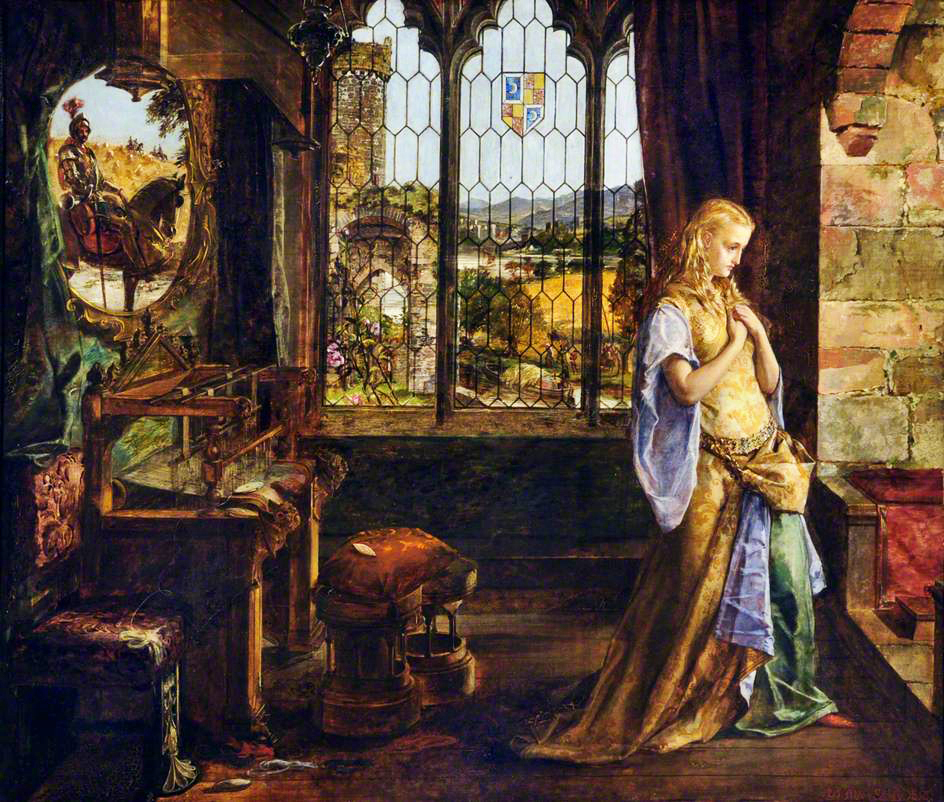Understanding the Lady of Shalott
Presented to you by Alexander Rzehak

The Lady and the Outside World
It’s ironic really that Tennyson chooses to center his poem on such a one-dimensional character, that being the Lady of Shalott. Victorian era poems are usually classified by their brightness in both tone and diction which is why I find it rather odd that the focus is on the Lady rather than Camelot. Tennyson seemed to promise an idyllic world in the first two stanzas by illustrating a medieval painting with his words. “Long fields of barley and rye” near a river whilst “lilies” billow in the wind seems like and ideal setting to be in.[1] But my hope for an uplifting scenic poem was dispelled by a woman locked within “four gray walls, and four gray towers.”[2] Tennyson thus shifts the tone immediately to a more mysterious and gloomier note. The imagery of nature, of freedom, of movement is effectively juxtaposed by the colorlessness of Shalott. Even the flowers described following the gray castle’s description are devoid of life. Tennyson makes no effort to paint their color nor their motion in the breeze, rather, they are “overlooked” by the castle as if being held prisoner. This severity introduced in the midst of nature’s healthy activity makes it seem that Shalott ought to be a place that should be isolated. Tennyson affirms this claim with the townspeople’s attitudes. Those who operate in close proximity to Shalott, that being the commonfolk of “barges” and “shallops,” haven’t the slightest clue of who the Lady is.
[1] Tennyson, the Lady of Shalott, 2-8
[2] Ibid, 15
A Reference to Greek Mythology
After reading through the entirety of the poem, my attitude shifted greatly as I realized Tennyson intended to create a story with a plot and twist. It became almost reminiscent of the epic poems I grew up reading, and I found many similar traits between the Lady of Shallot and the ancient tales. The Lady is initially depicted to be content with her isolation: her songs echo “cheerily,” her picture is weaved in “happy, gay colors,” and has “little other care” besides her craft.[1] However, like the “overlooked” flowers, she too appears to be a prisoner due to an unknown curse which forbids her from looking directly at Camelot. There is a stark connection to Greek mythology, specifically to Penelope. The wife of Odysseus avoided suitors attempting to court her while her husband was on his journey by constantly weaving.[2] Instead of men, the Lady of Shalott appears to be avoiding reality itself and has no desire to partake in the world around her. Only her songs escape her confines, and reapers deem her to be a fairy.
[1] Ibid, 38-44
[2] See Homer’s “Iliad” for full story. Brief explanation: Odysseus came up with a plan to allow the Greeks to sack the city of Troy. At Odysseus’ instruction, the Greeks built a large, hollow wooden horse. They presented this horse to the Trojans in the guise of a gift, but once the horse was inside the city, Greek soldiers burst out of it and destroyed Troy. This is where the phrase ”beware of Greeks bearing gifts” comes from, and the story is now known as the story of the Trojan Horse. While he is gone, a large and rowdy mob of suitors who have overrun Odysseus’s palace and pillaged his land continue to court his wife, Penelope. She has remained faithful to Odysseus. Prince Telemachus, Odysseus’s son, wants desperately to throw them out but does not have the confidence or experience to fight them. One of the suitors, Antinous, plans to assassinate the young prince, eliminating the only opposition to their dominion over the palace.
A Change of Perspective
Tennyson even makes an allusion to Plato’s allegory of the cave. Since the Lady of Shalott cannot see the world with her own eyes, her only line of sight to the outside world is a mirror that reflects its “shadows.” According to Plato, those who have no desire for a greater perspective of reality reside in the mouth of a cave, chained up and forever set in their ways until curiosity overcomes them. Stuck within this space, the cave dwellers see shadows of the bigger world outside in shadows that flicker on the walls of the cave and perceive it as reality. Therefore reality for the Lady of Shalott is the reflection she sees in the mirror, which is unable to pique her curiosity until Lancelot’s image appears on it. That combined with his song reach her heart effectively making her tempt fate by going to the window and seeing the world with her own eyes.
“She left the web, she left the loom,
She made three paces thro’ the room,
She saw the water-lily bloom,
She saw the helmet and the plume,
She look’d down to Camelot.”[1]
But as she does this, her life collapses as the mirror cracks and the tapestry unveils. Once she exposes herself to the outside world and leaves her ‘cave,’ she is subjected to the harshness of reality which she has restricted herself from participating in. Thus, her sense of self (the mirror) and all her accomplishments (the tapestry) crumble and fade away. This challenge to her ego leaves her broken and eventually results in her demise.
[1] Tennyson, the Lady of Shalott, 109-113





